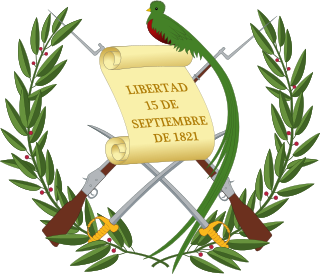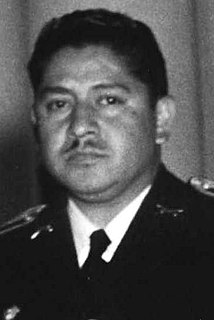 W
WThe Guatemalan Revolution was the period in Guatemalan history between the popular uprising that overthrew dictator Jorge Ubico in 1944 and the United States-orchestrated coup d'état in 1954 that overthrew the democratically elected President Jacobo Árbenz. This period has also been called the Ten Years of Spring, highlighting the only years of representative democracy in Guatemala from 1930 until the end of the civil war in 1996, which saw the implementation of a program of social, political, and especially agrarian reform that was enormously influential across Latin America.
 W
WParliamentary elections were held in Guatemala on 3–5 November 1944 to elect members of the Congress. The result was a victory for the United Front of Political Parties and Civic Associations (FUPP), which won all 76 seats. The FUPP was an alliance of the National Democratic Front, the Popular Liberation Front, the Central Democratic Party, the Social Democratic Party, the National Renovation Party and the National Vanguard Party.
 W
WPresidential elections were held in Guatemala between 17 and 19 December 1944. The result was a victory for Juan José Arévalo, who received 86.25% of the vote.
 W
WParliamentary elections were held in Guatemala between 24 and 26 January 1947 in order to elect half the seats in Congress. The Revolutionary Action Party won a plurality of seats.
 W
WParliamentary elections were held in Guatemala between 26 and 28 November 1948 in order to elect half the seats in Congress. The National Renovation Party-Revolutionary Action Party alliance won the most seats, but the Popular Liberation Front remained the largest party.
 W
WParliamentary elections were held in Guatemala for half the seats in Congress on 16 December 1950. The Revolutionary Action Party won a plurality of seats.
 W
WParliamentary elections were held in Guatemala for half the seats in Congress between 16 and 18 January 1953. The Revolutionary Action Party won a plurality of seats.
 W
WFrancisco Javier Arana Castro was a Guatemalan military leader and one of the three members of the revolutionary junta that ruled Guatemala from 20 October 1944 to 15 March 1945 during the early part of the Guatemalan Revolution. A major in the Guatemalan army under the dictator Jorge Ubico, he allied with a progressive faction of the army to topple Ubico's successor Federico Ponce Vaides. He led the three-man junta that oversaw the transition to a democratic government, although he was personally reluctant to allow the elected President Juan José Arévalo to take office in 1945. He served as the Chief of the Armed Forces in the new government until 1949. On 18 July 1949 he was killed in a shootout with supporters of the Arévalo government after he threatened to launch a coup.
 W
WJuan Jacobo Árbenz Guzmán was a Guatemalan military officer and politician who served as the 25th President of Guatemala. He was Minister of National Defense from 1944 to 1951, and the second democratically elected President of Guatemala, from 1951 to 1954. He was a major figure in the ten-year Guatemalan Revolution, which represented some of the few years of representative democracy in Guatemalan history. The landmark program of agrarian reform Árbenz enacted as president was very influential across Latin America.
 W
WJuan José Arévalo Bermejo was a professor of philosophy who became Guatemala's first democratically elected president in 1945. He was elected following a popular uprising against the United States-backed dictator Jorge Ubico that began the Guatemalan Revolution. He remained in office until 1951, surviving 25 coup attempts. He did not contest the election of 1951, instead choosing to hand over power to Jacobo Árbenz. As president, he enacted several social reform policies, including an increase in the minimum wage and a series of literacy programs. He also oversaw the drafting of a new constitution in 1945.
 W
WCarlos Castillo Armas was a Guatemalan military officer and politician who was the 28th president of Guatemala, serving from 1954 to 1957 after taking power in a coup d'état. A member of the right-wing National Liberation Movement (MLN) party, his authoritarian government was closely allied with the United States.
 W
WCarlos Enrique Díaz de León was the provisional President of Guatemala from 27 June to 29 June 1954. He was replaced by a military junta led by Elfego Monzón. Carlos Enrique Díaz was previously Chief of the Guatemalan Armed Forces under President Jacobo Árbenz.
 W
WAllen Welsh Dulles was the first civilian Director of Central Intelligence (DCI), and its longest-serving director to date. As head of the Central Intelligence Agency (CIA) during the early Cold War, he oversaw the 1953 Iranian coup d'état, the 1954 Guatemalan coup d'état, the Lockheed U-2 aircraft program, the Project MKUltra mind control program and the Bay of Pigs Invasion. He was fired by John F. Kennedy over the latter fiasco.
 W
WThe 1954 Guatemalan coup d'état, code-named Operation PBSuccess, was a covert operation carried out by the U.S. Central Intelligence Agency (CIA) that deposed the democratically elected Guatemalan President Jacobo Árbenz and ended the Guatemalan Revolution of 1944–1954. It installed the military dictatorship of Carlos Castillo Armas, the first in a series of U.S.-backed authoritarian rulers in Guatemala.
 W
WThe Guatemalan Party of Labour was a communist party in Guatemala. It existed from 1949 to 1998. It gained prominence during the government of Col. Jacobo Arbenz. It was one of the main forces of opposition to the various regimes that followed Arbenz's overthrow and became a constituent of the URNG guerrilla coalition during the later phase of the country's Civil War.
 W
WJohn Emil Peurifoy was an American diplomat, an ambassador in the early years of the Cold War. He served as United States ambassador in Greece and Thailand and was the United States Ambassador to Guatemala during the 1954 coup that overthrew the democratic government of Jacobo Arbenz.
 W
WThe United Fruit Company, now Chiquita Brands International, was an American corporation that traded in tropical fruit grown on Latin American plantations and sold in the United States and Europe. The company was formed in 1899, from the merger of Minor C. Keith's banana-trading concerns with Andrew W. Preston's Boston Fruit Company. It flourished in the early and mid-20th century, and it came to control vast territories and transportation networks in Central America, the Caribbean coast of Colombia, Ecuador, and the West Indies. Though it competed with the Standard Fruit Company for dominance in the international banana trade, it maintained a virtual monopoly in certain regions, some of which came to be called banana republics, such as Costa Rica, Honduras, and Guatemala.
 W
WThe Universidad de San Carlos de Guatemala is the largest and oldest university of Guatemala; it is also the fourth founded in the Americas. Established in the Kingdom of Guatemala during the Spanish colony, it was the only university in Guatemala until 1954.
 W
WDoña María Cristina Vilanova Castro de Árbenz was the First Lady of Guatemala from 1951-1954, as wife of the Guatemalan President Jacobo Árbenz Guzmán.
 W
WGeneral José Miguel Ramón Ydígoras Fuentes was the conservative President of Guatemala from 1958 to March 1963. He was also the main challenger to Jacobo Árbenz during the 1950 presidential election. He had previously served as the governor of the province of San Marcos.